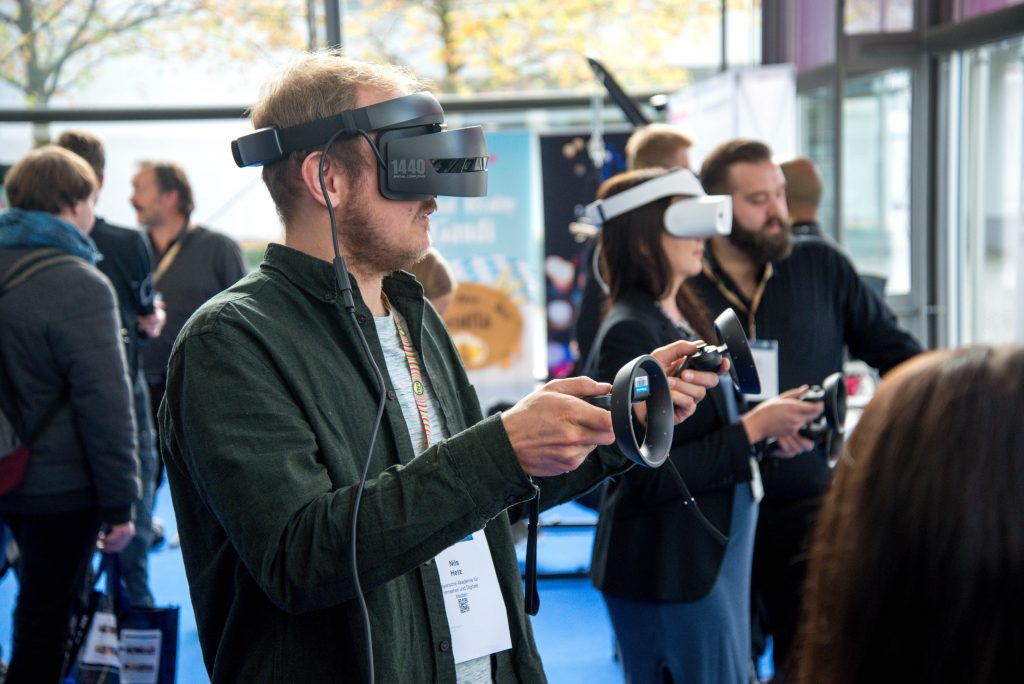Open Your Eyes: How Virtual Reality Lets Students Experience Learning in a New Way

Flipped classrooms and new tools such as virtual reality are giving students more chances to interact in the classroom. How instructors choose to implement these methods can drastically alter the learning experience.
The EvoLLLution (Evo): We’re talking about the benefits and impacts of adapting the classroom experience. Flipping the classroom is a concept we’ve talked about a number of times over the past two or three decades. How does this model help boost student engagement?
Wendy Schatzberg (WS): I had heard a lot about flipping the classroom. When COVID-19 hit and we all went remote, I decided that it provided an excellent opportunity to flip my classroom to engage students, rather than having them learn passively. I wanted my students to become more active. They’d have an assignment outside of class, I had lecture material online, they’d watch the lecture material and complete a worksheet outside of class. Then we’d have a synchronous aspect the next day, where we would go through the worksheet and students could see what they did right and wrong. And then we’d go through another worksheet in class.
It was an interesting flipped classroom model. It took about a week for my students to adjust to it because most of them were not used to it. Add that we were in the middle of a pandemic, so they had a lot of new variables to handle. After about a week, they loved it. They loved the engagement and being able to instantly identify the problems they were experiencing or what they were doing wrong. There was class cooperation because, inside Zoom, I’d put them into groups where they could work on the worksheet. They weren’t alone anymore.
And for the students that I had, who cannot attend the synchronous component, could do the worksheet alone. Some students tried to, but they usually came back because they missed the people. It was a great thing. What was interesting for me was finding that my students actually did better than they normally do. Their grades were higher. I was talking with the other professors, some remote and some in-person, and all of them saw their students’ grades drop. I was the only outlier of the group, which I partly attribute to the student engagement I had. I was doing a different thing than they were.
Evo: Why is a model like this such an outlier when it comes to teaching material in a post-secondary context?
WS: I’m a firm believer in practicing what I preach. If I’m going to say this is interesting pedagogy, I should be willing to do it myself. If I’m not willing to do it myself, why am I advocating for it? I taught in the fall and decided over the summer to change my curricula to a flipped classroom model online. It took a lot of work. I had to record my lectures, create a worksheet for that lecture, a key that I could give out, a worksheet for the lecture I did synchronously. And all of it had to be done before fall, so it did add a huge burden.
I couldn’t do anything on the fly. And I know some people like to be more on the spot and develop as needed. But flipping the classroom, at least in my experience, requires a lot of prep before a semester starts. Once a semester starts, you’re good. But before, all the burden to get everything done is on you. So, that was a deterrent and I’m very open about it when I talk to other faculty. It is really great for student engagement. My students do really well with flipped classrooms. My students do tend to perform better than when I just do a normal lecture classroom. But there’s a lot more burden on the professor. There was also a lot more grading. I found that I had to readjust my expectations of the number of hours per week I needed to spend grading. And I can understand how somebody who is swamped with a lot of classes, a lot of work, might not have the upfront prep time or might not have an extra hour or two a week to devote to their students. So, I think that’s part of the cons. Along with having to convince students in the first week that just because this was new, it didn’t necessarily mean it was bad.
Evo: You’ve talked in the past about VR for educational purposes. How can instructors better implement this kind of technology to support their students’ learning?
WS: I am dabbling in VR. Some of my faculty friends and acquaintances are integrating VR into their classroom. One is in dentistry and has developed a VR headset with a few other people. And you can play around with somebody’s mouth without actually needing a live human being, which is good for beginner users. Beginner students don’t necessarily need to practice on a real-life human being who can feel pain.
I think most of us would want to be that human. As much as it does cost money for a headset and the software and the programming, they do have models or dolls that students use. And those are really expensive and wear out. So, VR is a different way of doing it. You could also give VR assignments to students at home, rather than saying they have to come into a building and play with the doll or find a live human being. So, for really expensive things, VR is a way around it or that gives you portability you wouldn’t normally have. I know people teaching anatomy classes and they can separate out different organs and take a look at what the heart looks like from the top down, from the side, from the back or with the bone structure around.
And it’s hard to do and visualize that. I mean, there are some things you can visualize in 2D, but 3D is a whole different beast. What does the muscle look like around that? And you can take it out and put it back in and take it out and put it back in? Chemistry-wise, visualizing atoms is very, very difficult. What’s the size of the nucleus versus that of an electron? How do bonds happen? What’s the difference between a metal and a nonmetal? And this is a way in which you can twist and turn—different geometries are very important.
You can visualize really, really well. We have a physics professor who’s turning his entire lab into a VR lab. So, students could take a physics lab anywhere they want, as long as they have an appropriate VR headset. He’s developing it now and should be able to implement it in about a year or so. And he’s going to assess the VR lab versus the in-person lab, and all the experiments are the same. One’s just VR and one’s just in person. It’s a different way of visualizing or giving that experience without requiring all the accoutrements.
Evo: Do you see use cases for VR-style technology in non-scientific fields?
WS: Yes, I just have a bias—I fully admit. You can have other experiences. I was just down in Vegas, and they had the Van Gogh experience with VR headsets that allowed you to walk through the paintings. It’s a different way of experiencing the artwork. And you could easily integrate this into something like art history, walking through this experience. Or for English, you can set up a simulation of the 1800s and walk through. Some people are doing escape rooms or murder mystery instead of just having you read about the genre. You actually experience the genre and kind of gamify it. It’s a new way of incorporating students into the lecture and material rather than having them passively experience it.
Evo: When you look at the scale or capacity for VR and AR learning technologies, they vary in terms of depth or scope. But at the end of the day, none of it is particularly cheap. Have you seen any kind of alternatives to VR that schools can adopt?
WS: There are different levels of access to VR. Some places have a VR center that offers different headsets that students can check out and experience that way. And faculty would also get to do this. This is the model that we are trying to go to just to keep costs down. With online, you would have to say, “Hey, if you wanted to be across the country, you’re going to have to buy your own headset. Sorry.” But the plus is that you can be anywhere.
As for development, the center of teaching and learning has mini grants, and we give up to $5,000 for different innovative projects. We’ve had people use VR. That seems to be the way that a lot of people want to use their grant money. They’ve created VR tours of campus that anybody can take without actually being here, especially new incoming students. And they did it with $5,000. So, development doesn’t have to be expensive—you can make it as expensive and interactive as you want. It really depends on your learning goals and your availability with your students.
Evo: How do you see these technologies and innovations starting to shape what distance education looks like?
WS: Part of the issue with a lot of distance education is the question of giving an active learning experience. I see parallels with a lecture classroom. A lecture classroom was originally designed as a passive learning experience. Students sit there, with the teacher at the front of the classroom. And we’ve started becoming more active. Students are going to do, think, pair, share. They’re going to inquire. In distance learning, it’s easy to do it passively and asynchronously there, but as you get more comfortable with designing it, then it gets more active. Think: How do I give more of an experience to my students rather than having them sitting there watching me lecture on a screen? You give them activities, you do the flipped classroom, you want students to do something, rather than I talk, you get bored and listen.
I see VR as another way of doing it, especially like certain things that have adaptability like physics or chemistry labs. I wouldn’t want them to be 100% VR because you do need some experience with real-life chemicals. That has its own unique experience, but you can possibly give more experience to the learners by just having it be an add-on. So, some classrooms might be an add-on. Some of it might be able to be fully developed, depending on the person and the context.
This interview was edited for length and clarity.
Author Perspective: Administrator



